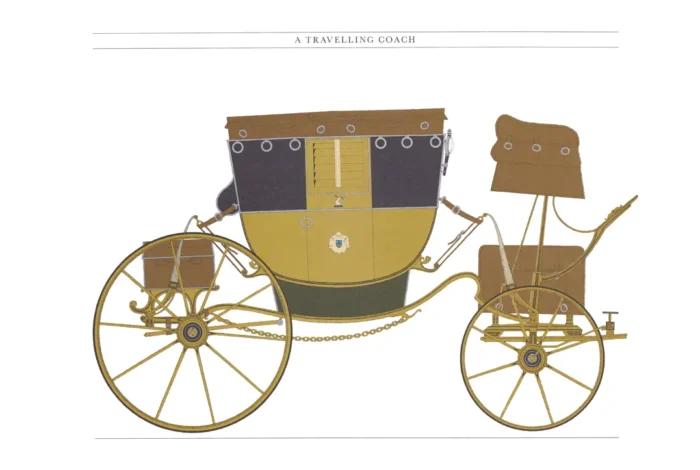Travelling Coach
Original price was: £25.00.£17.50Current price is: £17.50.
Published 1962 © Hugh Evelyn Limited; artist Alan Osbahr;
c. 34 x 24 cm (13″ x 9″) on high white matt cardstock of 115 g/m²;
Shown here is a scan of the print.
This is a STANDARD sized print; see mail costs at Shipping & Returns.
Detail below
In stock
- Satisfaction Guaranteed
- No Hassle Refunds (see Shipping and returns)
- Secure Payments
Description
Summary
A stagecoach is a four-wheeled public transport coach used to carry paying passengers and light packages on journeys long enough to need a change of horses. It is strongly sprung and generally drawn by four horses although some versions are drawn by six horses. Commonly used before steam-powered rail transport was available, a stagecoach made long scheduled trips using stage stations or posts where the stagecoach’s horses would be replaced by fresh horses. The business of running stagecoaches or the act of journeying in them was known as staging. Some familiar images of the stagecoach are that of a Royal Mail coach passing through a turnpike gate, a Dickensian passenger coach covered in snow pulling up at a coaching inn, a highwayman demanding a coach to “stand and deliver” and a Wells Fargo stagecoach arriving at or leaving a Wild West town. The yard of ale drinking glass is associated by legend with stagecoach drivers, though it was mainly used for drinking feats and special toasts. Until the late 18th century, stagecoaches travelled at an average speed of about 5 miles per hour (8 km/h), with the average daily mileage traversed approximately 60 to 70 miles (97 to 113 km), The period from 1800 to 1830 saw great improvements in the design of coaches, most notably by John Besant in 1792 and 1795. His coach had a greatly improved turning capacity and braking system, and a novel feature that prevented the wheels from falling off while the coach was in motion. Besant, with his partner John Vidler, enjoyed a monopoly on the supply of stagecoaches to the Royal Mail and a virtual monopoly on their upkeep and servicing for the following few decades
Fentons Description of a Private Travelling Coach
STRENGTH and convenience are the most essential properties of this carriage, it being principally intended for continental journeys, nothing should be omitted that can contribute to either; plain, strong built crane-neck carriages are to be preferred on this occasion, as the roads on the continent are very rough, and in the towns very narrow; and as there is not much opportunity for cleaning or mending on the way, the plainer and the stronger they are built, the better for the purpose. The great expense of these carriages is principally because of the many conveniences for luggage necessary for the passengers’ accommodation, it depends on the knowledge of the intended route to proportion the carriage and conveniences thereto, so that all unnecessary encumbrance may be avoided to save both toil and expense. First charge for crane neck coach £121 4s 0d. Patent anti-Attrition Axeltrees and Boxes £15 14s 0d. [William Fenton, 1789]
| First charge for crane neck coach | £121 | 4 | 0 |
| Patent anti-Attrition Axletrees and Boxes | 15 | 14 | 0 |
| EXTRAS TO DITTO | |||
| A raised hind end with short plain blocks | 1 | 10 | 0 |
| A common Coach-box with a travelling Seat | 9 | 3 | 6 |
| A large platform Budget | 8 | 0 | 0 |
| A large Trunk for ditto with inside Straps and Laths | 3 | 19 | 6 |
| Leather belts for fixing ditto | 0 | 7 | 6 |
| A large trunk for the hind end with inside straps and Laths | 3 | 19 | 6 |
| An oil cloth Cover for the Trunk | 0 | 10 | 6 |
| A pair of Leather Belts 9 feet long | 0 | 11 | 0 |
| A Chain belt for security 9 feet long | 0 | 17 | 6 |
| The springs corded | 1 | 1 | 0 |
| A drag Staff with a chain | 0 | 18 | 0 |
| A Tool budget | 0 | 10 | 6 |
| A Sword case or Boodge | 2 | 10 | 0 |
| A set of inside silk Squabs | 4 | 0 | 0 |
| 60 feet off;-8th moulding | 5 | 10 | 1 |
| A set of Circles for head plates | 1 | 0 | 0 |
| A pair of sword case frames and octagon, do. | 0 | 16 | 0 |
| Venetian blinds in lieu of shutters | 2 | 5 | 0 |
| A pair of best Imperials for the roof | 11 | 0 | 0 |
| A large well for the bottom | 2 | 12 | 6 |
| Two mantles with cyphers on the doors | 1 | 2 | 0 |
| Two crests on the door styles | 0 | 8 | 0 |
| TOTAL | £199 | 10 | 1 |
Additional information
| Dimensions | 38 × 25.5 cm |
|---|




